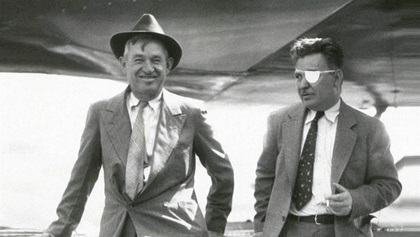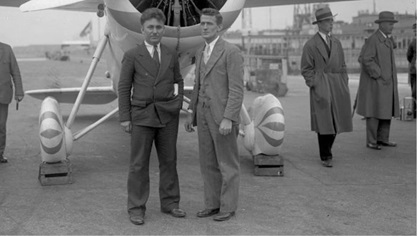Wiley Post Airport, Oklahoma
Okies fly high and far, under pressure

One was Wiley Post, a pioneering aviator of the 1920s and ’30s who was the first pilot to fly solo around the world. He became known for record flights, research in high-altitude flying, and the development of pressure suits. To honor this Okie who went from the oil fields to the sky, the general aviation airport in Oklahoma City was named Wiley Post Airport.
His friend, humorist Will Rogers, whose most famous quote might be, “I never met a man I didn’t like,” is memorialized by the Oklahoma City commercial airport being dubbed Will Rogers World Airport. Fittingly, the airport for real pilots is named for Post, while the one for those funny folks who sit in the back of airliners, for Rogers.
Wiley Hardeman Post (1898-1935) was born on a Texas farm, but his family moved to Oklahoma when he was five, the year the Wright brothers flew at Kill Devil Hills. Post completed an enlistment in the Army during World War I and then performed as a parachutist for a barnstorming circus. He worked in the Oklahoma oil fields until an accident blinded his left eye, for which he received enough money in compensation to buy a Canadian Curtiss “Canuck” biplane. His eye patch made him an easily recognizable figure.
 Post became the personal pilot of a wealthy Oklahoma oilman, F.C. Hall, who sponsored Post in the 1930 National Air Races. Hall purchased a Lockheed Vega for Post to fly, which they named after Hall’s daughter, Winnie Mae. Post won the race from Los Angeles to Chicago that year. In 1931, Post and Harold Gatty flew Winnie Mae around the world in eight days, beating the previous record by the Graf Zeppelin of 21 days. Post flew it around the world again in 1933, this time solo. He became interested in high-altitude flying and worked with the B.F. Goodrich Company to develop the first pressure suit. Suited up with a tin-can helmet, Post resembled a deep-sea diver. During flights using the suit, Post reached as high as 50,000 feet and discovered the jet stream.
Post became the personal pilot of a wealthy Oklahoma oilman, F.C. Hall, who sponsored Post in the 1930 National Air Races. Hall purchased a Lockheed Vega for Post to fly, which they named after Hall’s daughter, Winnie Mae. Post won the race from Los Angeles to Chicago that year. In 1931, Post and Harold Gatty flew Winnie Mae around the world in eight days, beating the previous record by the Graf Zeppelin of 21 days. Post flew it around the world again in 1933, this time solo. He became interested in high-altitude flying and worked with the B.F. Goodrich Company to develop the first pressure suit. Suited up with a tin-can helmet, Post resembled a deep-sea diver. During flights using the suit, Post reached as high as 50,000 feet and discovered the jet stream.
 Post became friends with Rogers, America’s most beloved humorist, social commentator, and movie comedian. Rogers was an aviation enthusiast and frequently wrote about Post’s accomplishments in his newspaper column. In 1935, Rogers accompanied Post on a flight from Seattle to Russia in an airplane built by Post, who mounted the wings of a Lockheed Explorer to the fuselage of a Lockheed Orion and attached floats. The combination was nose heavy and ultimately dangerous. On August 15, 1935, Post and Rogers died when the aircraft crashed on takeoff from a lagoon near Point Barrow, Alaska. The loss of two icons of U.S. culture during the Great Depression sent the nation into a state of mourning that was rarely seen for private citizens. Flags were lowered to half-staff and movie screens went dark for two minutes in tribute.
Post became friends with Rogers, America’s most beloved humorist, social commentator, and movie comedian. Rogers was an aviation enthusiast and frequently wrote about Post’s accomplishments in his newspaper column. In 1935, Rogers accompanied Post on a flight from Seattle to Russia in an airplane built by Post, who mounted the wings of a Lockheed Explorer to the fuselage of a Lockheed Orion and attached floats. The combination was nose heavy and ultimately dangerous. On August 15, 1935, Post and Rogers died when the aircraft crashed on takeoff from a lagoon near Point Barrow, Alaska. The loss of two icons of U.S. culture during the Great Depression sent the nation into a state of mourning that was rarely seen for private citizens. Flags were lowered to half-staff and movie screens went dark for two minutes in tribute.
Post was buried at Memorial Park Cemetery in Oklahoma City, and Rogers lies at the Will Rogers Memorial Museum in Claremore, Oklahoma, 30 miles northeast of Tulsa.
The Winnie Mae is displayed at the National Air and Space Museum in Washington, D.C., along with other Post artifacts, including his pressure suit and a cracked compass recovered from his 1935 crash.
Dennis K. Johnson is an aviation writer and frequent contributor to AOPA media.
Things to see and do
99s Museum of Women Pilots
The 99s Museum of Women Pilots, on the grounds of Will Rogers World Airport, exhibits artifacts spanning the history of women in aviation, including Louise Thaden’s Travel Air, in which she won the 1929 Transcontinental Race for Women.
museumofwomenpilots.org
The National Cowboy and Western Heritage Museum
The National Cowboy and Western Heritage Museum exhibits Western art and historic artifacts of cowboy culture.
nationalcowboymuseum.org
American Banjo Museum
The American Banjo Museum celebrates the music and history of America’s favorite stringed instrument, with more than 300 banjos on exhibit.
americanbanjomuseum.com
Stockyards City
Experience the cowboy life by attending a cattle auction, rodeo, or the annual Stockyards Stampede at the historic Stockyards City.
stockyardscity.org
Oklahoma City National Memorial and Museum
Visit the Oklahoma City National Memorial and Museum to remember and learn about America’s worst case of domestic terrorism: the bombing of the Alfred P. Murrah Federal Building in 1995.
memorialmuseum.com
Stafford Air and Space Museum
Named for Apollo astronaut and native Oklahoman Thomas Stafford, the Stafford Air and Space Museum exhibits items spanning aviation’s history, including Stafford’s Gemini VI spacecraft, his Gemini and Apollo spacesuits, and a moon rock. The museum is in Weatherford, Oklahoma.
staffordmuseum.org


